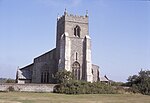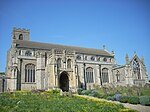Blakeney Windmill
Blakeney, NorfolkGrade II listed buildings in NorfolkGrade II listed windmillsGrinding mills in the United KingdomNational Trust properties in Norfolk ... and 6 more
Norfolk building and structure stubsNorfolk geography stubsNorth NorfolkTower mills in the United KingdomWindmills completed in 1769Windmills in Norfolk

Blakeney Tower Windmill, built in 1769, is located on Friar Farm just to the east of the village of Blakeney in the English county of Norfolk. The mill, which today is owned by the National Trust, stands in a static caravan site. The building has been evaluated due to its historic interest as a Grade II listed building.
Excerpt from the Wikipedia article Blakeney Windmill (License: CC BY-SA 3.0, Authors, Images).Blakeney Windmill
Back Lane, North Norfolk Blakeney
Geographical coordinates (GPS) Address Nearby Places Show on map
Geographical coordinates (GPS)
| Latitude | Longitude |
|---|---|
| N 52.954388888889 ° | E 1.0252583333333 ° |
Address
Friary Farm Caravan Park
Back Lane
NR25 7NP North Norfolk, Blakeney
England, United Kingdom
Open on Google Maps










